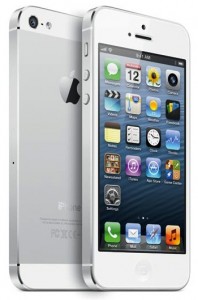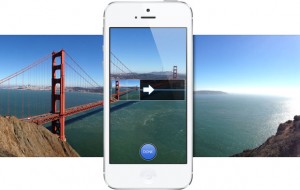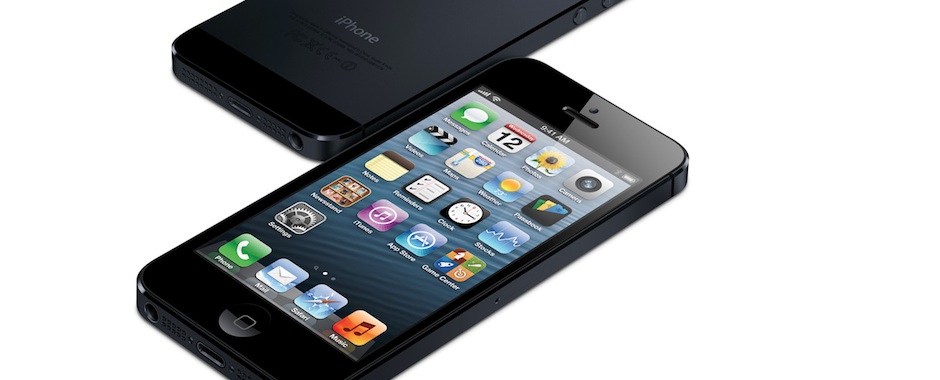We certainly don’t need to tell you that Apple’s next Jesus Phone has arrived, but we thought we’d give it a short but sweet review. We’ll take a look at the big things and weigh in on some of iOS 6’s latest offerings.
iPhone hardware has always been beautiful, and while we thought nothing could look as good as our iPhone 4, we were wrong. Something about the iPhone 5 has it sparkling like a jewel. The bezel around the phone that has been diamond cut to give it a near-mirror finish and the perfect weight of the device all contribute to this being the most beautiful phone in existence. Yes, even more so than Vertu’s offerings.
Speaking of the weight of the device, iPhone 5 is quite possibly the most perfectly weighted phone we’ve ever used. With a case on it, it matches the bare-phone weight of the iPhone 4/4S, and in doing so, gives us a bit of a lighter device that is more easily pocketable, even if the screen – and therefore, the device – is larger.
The screen has always been the main feature of any iPhone, and Cupertino’s latest is no exception. You won’t notice a massive difference between this display and the previous two iPhone generations (they are both retina displays, after all), but in a side-by-side comparison, the pixels do seem to squeeze out better colour and more vivid whites. The screen is, of course, taller now, at 4 inches, and for a reason that we’ve postulated before: one-handed operation is still doable on a four-inch device. Try using a Galaxy S III with one hand and you’ll either drop it trying to shift it around in your hand or you won’t be able to ready one quarter of the screen. The iPhone 5’s screen size also makes it a lot more pocketable than anything of S III size and up.
 The new dock connector is welcome, although we’ll admit it’s taken some getting used to. Not because we have any problem using a smaller connector, but because, realistically, we just don’t have a Lightning cable lying in each room of the house like we do with dock connector cables. We’ll get used to it, and we suppose it’ll become less of an issue when the new iPad gets a Lightning connector and we have more lying about. For those wondering (and those who care), Apple had a very good reason for going all-digital with their new connector, and Engadget breaks it down for you here.
The new dock connector is welcome, although we’ll admit it’s taken some getting used to. Not because we have any problem using a smaller connector, but because, realistically, we just don’t have a Lightning cable lying in each room of the house like we do with dock connector cables. We’ll get used to it, and we suppose it’ll become less of an issue when the new iPad gets a Lightning connector and we have more lying about. For those wondering (and those who care), Apple had a very good reason for going all-digital with their new connector, and Engadget breaks it down for you here.
The difference in cameras from the iPhone 4 that we’ve been using to the new one on the iPhone 5 has been more stunning than we were expecting. Granted, the change is not as big as it would be from iPhone 4S to 5, but if you’re upgrading from an iPhone 4, you’re in for a real treat. The camera’s optics themselves just look better overall as the lens system in the camera has been improved as well as the lighting system and overall structure of the phone. Photos outdoors are nothing short of beautiful, and they rival any sort of point-and-shoot quality from any sub-$300 camera in our estimation.
 The biggest jump for the camera in the iPhone 5 (although this functionality does translate to the iPhone 4S with iOS 6) is the panorama feature. The A6 chip in the iPhone 5 is an incredible chip, and here’s why: it has the ability to stitch together a full 28-megapixel photo in realtime, while its pulling images into the sensor. For anyone who has tried to stitch together four or five photos in Photoshop on a fully-featured computer (likely running a desktop processor clocked north of 2GHz), this is incredible. And in a mobile device. The sheer power behind the A6 chip is incredible, and it’s clear that this power can only grow to include larger photos and better imaging going forward. Imagine Apple’s panoramas on an iPad capable of 12 or 14 megapixel photos and you have an idea of what we’re talking about. If the imaging even just gets marginally better, we’re talking about print quality visuals from portable devices with imaging as their secondary function. Incredible.
The biggest jump for the camera in the iPhone 5 (although this functionality does translate to the iPhone 4S with iOS 6) is the panorama feature. The A6 chip in the iPhone 5 is an incredible chip, and here’s why: it has the ability to stitch together a full 28-megapixel photo in realtime, while its pulling images into the sensor. For anyone who has tried to stitch together four or five photos in Photoshop on a fully-featured computer (likely running a desktop processor clocked north of 2GHz), this is incredible. And in a mobile device. The sheer power behind the A6 chip is incredible, and it’s clear that this power can only grow to include larger photos and better imaging going forward. Imagine Apple’s panoramas on an iPad capable of 12 or 14 megapixel photos and you have an idea of what we’re talking about. If the imaging even just gets marginally better, we’re talking about print quality visuals from portable devices with imaging as their secondary function. Incredible.
The biggest thing for the iPhone 5 for us is actually the connectivity. iPhone 5 is compatible with LTE networks, which means we’ve been seeing regular speeds of about 30Mbps downloading and 25Mbps uploading. Compare this to our home cable line which gets the same 30Mbps down, but only about 1-2Mbps up. On a good day. If we didn’t have a bandwidth cap on our phone, we’d scrap the home internet line altogether and just tether all day.
![]() iOS 6 is the other big reason to talk about Apple lately, even though you can indeed get the software on iPhone 3GS, 4, and 4S, iPod touch, and iPads as far back as the iPad 2. So what’s new here? Well, Apple has been bouncing back and forth from iOS to Mac OS X in a way that one operating system influences the other which in turn influences the other which, once again, influences the other. With iOS 6, we’re seeing things like the ability to post to Facebook and Twitter right from notification centre.
iOS 6 is the other big reason to talk about Apple lately, even though you can indeed get the software on iPhone 3GS, 4, and 4S, iPod touch, and iPads as far back as the iPad 2. So what’s new here? Well, Apple has been bouncing back and forth from iOS to Mac OS X in a way that one operating system influences the other which in turn influences the other which, once again, influences the other. With iOS 6, we’re seeing things like the ability to post to Facebook and Twitter right from notification centre.
Of course, the big thing in iOS 6 is Apple’s abandonment of Google’s mapping software in favour of Apple-designed maps. We love the cartography in the maps that we actually want to use the non-satellite view, something we seldom, if ever, did with Google’s solution. With that said, fine, Apple hasn’t covered as much of the world nor does it have crystal clear imagery or Street View, but at the end of the day, I don’t care about any of that. I need the maps to get me places, and as an Apple product, I expect it to be beautiful. And Apple’s maps are certainly more beautiful than Google’s. In any case, read more about how we think Apple’s choices are strategic as opposed to missteps.
We won’t get into Passbook since there aren’t any great apps that support it yet in Canada, with the exception of Ticketmaster, Cineplex Odeon, Sephora, and a few travel companies. There haven’t been any major reported problems from what we can tell, so it seems that the service is working quite well, but we can’t officially corroborate that story.
The overall experience is what you’re buying when you purchase any Apple product. If you’ve got multiple products and services from Apple – say, an iPhone, MacBook Pro, and iCloud – then you’ve got one hub that is constantly connected and always ready to go with all your content. Even if the iPhone were our only device, the user experience on this four-inch screen alone is more than enough to keep us attracted to the software. Apple does one hell of a job to make the iPhone 5 an incredible device, dethroning the iPhone 4S as the best smartphone in the world.

